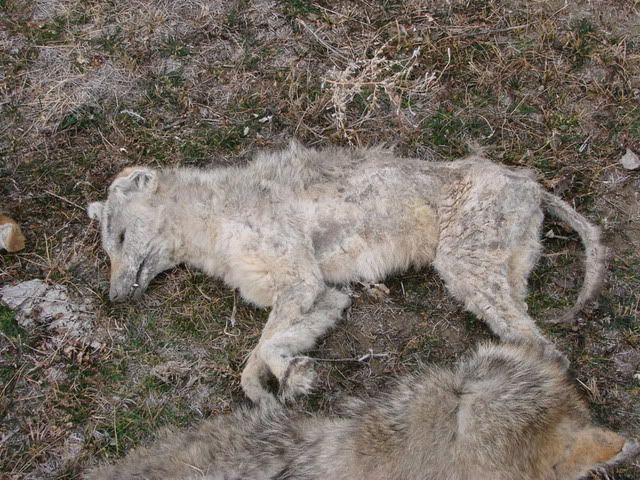There are 3 types of mange. Here is a good explanation. This is copyrighted material, but as long as we (I) give them credit and it is for personal learning purposes, it's OK to re-print it here. If the moderators feel it's not, then please delete with my apologies, but I feel since Mange can be contracted to (in) humans it is good to know this stuff.
--------------------------------------------------------
Demodectic Mange
Demodectic mange is caused by Demodex canis, a tiny mite that cannot be seen without the aid of a microscope. This mange strikes puppies from three to 12 months old.
The demodex mite is commonly present in the pores of puppy skin and usually does not cause symptoms, and it not at all certain what causes them to activate. The mites can produce a substance that lowers the dog's resistance to them and make use of an opportunity to multiply.
It's also possible that some lines of purebred dogs carry lowered resistance to the mites, and that stress can trigger an active infestation. In any case, demodectic mange symptoms include thinning of the hair around the eyes and mouth and on the front legs that evolves into patches of hair loss approximately one inch in diameter. This mange may correct itself within three months or may require treatment.
However, demodectic mange can also begin as a localized infestation and develop into a generalized case with multiple hair-loss sites on the dog's head, legs, and body. This is a far more serious condition and requires veterinary attention. The dog's skin is sore, crusty, and oozing; the hair follicles are clogged with mites and debris. Treatment is extended and requires bathing in medicated shampoo and application of an insecticide to kill the mites.
--------------------------------------------------------------------------------
Cheyletiella mange
Cheyletiella mange is also known as walking dandruff. It affects puppies and is caused by a large reddish mite that can be seen under a magnifying glass. This mange is identified by the dandruff dusting that occurs over the dog's head, neck, and back.
Walking dandruff is highly contagious but short-lived. It causes mild itching. The mite that causes the mange dies a short time after leaving the host.
--------------------------------------------------------------------------------
Sarcoptic mange
Sarcoptic mange, also known as scabies, is caused by a microscopic mite. The female mite causes the characteristic intense itching as they burrow under the skin to lay their eggs. The eggs hatch in a few days, develop into adults, and begin laying their own eggs in less than three weeks.
Dogs with scabies dig and bite at themselves with great ferocity. Their skin reacts with oozing sores, and secondary infection may set in, requiring treatment with an antibiotic in addition to treatment for the mites. Unfortunately, the sarcoptic mange mite can be difficult to find in skin scrapings, and unless the veterinarian parts the hair and carefully examines the bare skin for the characteristic pin-point bite marks, diagnosis is difficult. Furthermore, the presence of a secondary skin infection can hamper the search for the mite bite marks.
Telltale signs of sarcoptic mange are crusty ear tips, fierce itching, and hair loss, particularly on the ears, elbows, legs, and face in the early stages. Later on, the hair loss spreads throughout the body.
Sarcoptic mange is contagious to canines and humans. If the dogs share sleeping places or if the infected dog sleeps on beds or furniture, everyone will begin scratching. It is not unheard of for the family dog to infest the kids, the kids to infest their playmates, and the playmates to infest their pets and parents with scabies. Fortunately scabies in humans is self-limiting, that is the mite can burrow under the skin and cause itching, but cannot complete its life cycle on humans and dies within a few weeks.
Veterinarians now use Ivermectin in two doses, two weeks apart, to kill the mites. They may also prescribe steroids for short-term use to relieve the itching until the mites begin to die off and give the dog some relief. Itching usually begins to subside within a few days of the first dose of Ivermectin.
Canine skin damaged by sarcoptic mange and secondary skin infections can take weeks or months to recover, depending on the scope of the problems. Frequent medicated baths may be necessary to soothe irritated skin.
Mange damage can mimic that caused by other skin conditions, including autoimmune diseases, bacterial infections secondary to flea allergies, and contact dermatitis, making it impossible for the pet owner to diagnose with any success. If your dog suffers from irritated, itchy skin, make an appointment with the veterinarian. Early diagnosis of any of these problems will give you a head start on a cure and will be less uncomfortable for the dog and your wallet.
Norma Bennett Woolf
--------------------------------------------------------------------------------
[Dog Owner's Guide: Mange (www.canismajor.com/dog/mange1.html)] is a part of the Dog Owner's Guide internet website and is copyright 2006 by Canis Major Publications. You may print or download this material for non-commercial personal or school educational use. All other rights reserved


